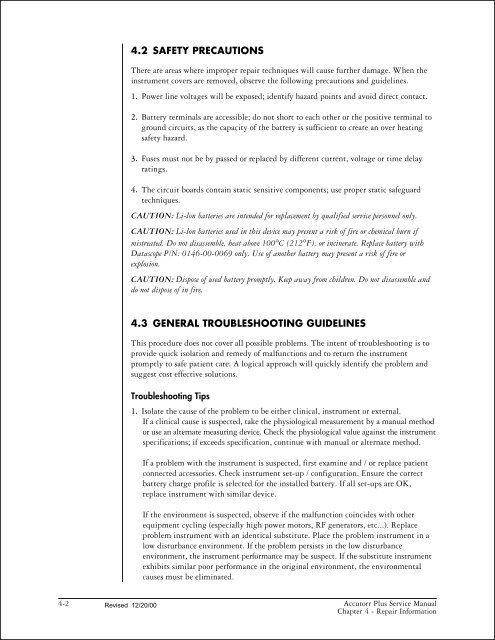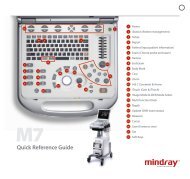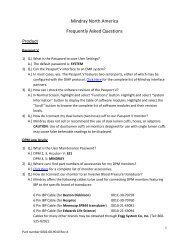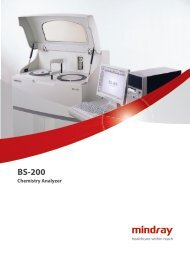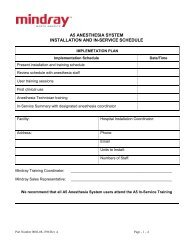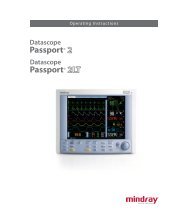Accutorr Plus Service Manual - Mindray
Accutorr Plus Service Manual - Mindray
Accutorr Plus Service Manual - Mindray
Create successful ePaper yourself
Turn your PDF publications into a flip-book with our unique Google optimized e-Paper software.
4.2 SAFETY PRECAUTIONS<br />
There are areas where improper repair techniques will cause further damage. When the<br />
instrument covers are removed, observe the following precautions and guidelines.<br />
1. Power line voltages will be exposed; identify hazard points and avoid direct contact.<br />
2. Battery terminals are accessible; do not short to each other or the positive terminal to<br />
ground circuits, as the capacity of the battery is sufficient to create an over heating<br />
safety hazard.<br />
3. Fuses must not be by passed or replaced by different current, voltage or time delay<br />
ratings.<br />
4. The circuit boards contain static sensitive components; use proper static safeguard<br />
techniques.<br />
CAUTION: Li-lon batteries are intended for replacement by qualified service personnel only.<br />
CAUTION: Li-lon batteries used in this device may present a risk of fire or chemical burn if<br />
mistreated. Do not disassemble, heat above 100C (212F), or incinerate. Replace battery with<br />
Datascope P/N: 0146-00-0069 only. Use of another battery may present a risk of fire or<br />
explosion.<br />
CAUTION: Dispose of used battery promptly. Keep away from children. Do not disassemble and<br />
do not dispose of in fire.<br />
4.3 GENERAL TROUBLESHOOTING GUIDELINES<br />
This procedure does not cover all possible problems. The intent of troubleshooting is to<br />
provide quick isolation and remedy of malfunctions and to return the instrument<br />
promptly to safe patient care. A logical approach will quickly identify the problem and<br />
suggest cost effective solutions.<br />
Troubleshooting Tips<br />
1. Isolate the cause of the problem to be either clinical, instrument or external.<br />
If a clinical cause is suspected, take the physiological measurement by a manual method<br />
or use an alternate measuring device. Check the physiological value against the instrument<br />
specifications; if exceeds specification, continue with manual or alternate method.<br />
If a problem with the instrument is suspected, first examine and / or replace patient<br />
connected accessories. Check instrument set-up / configuration. Ensure the correct<br />
battery charge profile is selected for the installed battery. If all set-ups are OK,<br />
replace instrument with similar device.<br />
If the environment is suspected, observe if the malfunction coincides with other<br />
equipment cycling (especially high power motors, RF generators, etc...). Replace<br />
problem instrument with an identical substitute. Place the problem instrument in a<br />
low disturbance environment. If the problem persists in the low disturbance<br />
environment, the instrument performance may be suspect. If the substitute instrument<br />
exhibits similar poor performance in the original environment, the environmental<br />
causes must be eliminated.<br />
4-2 Revised 12/20/00<br />
<strong>Accutorr</strong> <strong>Plus</strong> <strong>Service</strong> <strong>Manual</strong><br />
Chapter 4 - Repair Information


